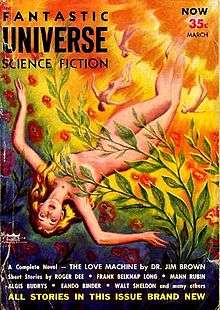James Cooke Brown
| Born |
James Cooke Brown July 21, 1921[1] Tagbilaran, Bohol, Philippine Islands[1] |
|---|---|
| Died |
February 13, 2000 (aged 78) Tierra del Fuego, Argentina[2] |
| Pen name | Jim Brown |
| Occupation | Linguistics[1] |
| Education | B.A., University of Minnesota 1946, Ph.D., 1948[1] |
| Genre | Science fiction |
| Spouse |
(1st wife) Lujoye Fuller Brown[3] (2nd wife) Evelyn Ruth Anderson[4] |
| Children |
Jefferson(born 1944), Jill(born 1945), Jennifer Fuller Brown(born 1965)[1][4] |
| Relatives | Parents: Bryan Burtis Brown and Violet Mary Cooke[1] |

Dr. James Cooke Brown (July 21, 1921 – February 13, 2000) was a sociologist and science fiction author.[5] He is notable for creating the artificial language Loglan and for designing the Parker Brothers board game Careers.[6]
Brown's novel The Troika Incident (Doubleday, 1970)[7] describes a worldwide free knowledge base similar to the Internet. The novel begins with the belief that the world is on the eve of self-destruction, but then it presents a world about a century from now which is a paradise of peace and prosperity, all based on ideas, movements, and knowledge presently available in the world. In its metafictional structure, the novel is a call for social change, not through revolution but through free education and the resilience of human ingenuity. Long out of print and relatively rare, an e-book version (Amazon Kindle) of the novel was released in 2012. The novel envisioned all books and periodicals being viewed on portable electronic devices called "readers" in the year 2070, when it is set.
Among his other achievements, Brown designed, and had built, a three-hulled sailboat, called a trimaran. He utilized this boat to sail to many parts of the world.
While on a South American cruise with his wife, Brown was admitted to a hospital in Argentina, where he died at the age of 78.[2]
Bibliography
Science Fiction
- The Emissary, Astounding Science Fiction
- "The Love Machine" Fantastic Universe [8]
- The Troika incident: a tetralogue in two parts - James Cooke Brown, Doubleday, 1970
Sociology
- Cooperative group formation: a problem in social engineering, Univ. of Minnesota., 1951[9]
- The Job Market of the Future: Using Computers to Humanize Economies, James Cooke Brown, M.E. Sharpe, 2001, ISBN 978-0-7656-0733-1
- Paternity, Jokes and Song : A Possible Evolutionary Scenario for the Origin of Mind and Language, BROWN J. C. ; GREENHOOD W., 1983, vol. 8, no2, pp. 7–53 (5 p.), Journal of Social and Biological Structures, ISSN 0748-772X
Loglan
- Loglan 1: a logical language, James Cooke Brown, Loglan Institute, 1975
- Loglan 2: methods of construction, James Cooke Brown, Loglan Institute, University Microfilms, 1981
- Loglan 3: speaking Loglan : programmed textbook on the phonology, basic vocabulary, and grammar of the simple Loglan sentence, James Cooke Brown, Lujoye Fuller Brown, Loglan Institute, University Microfilms, 1965
- Loglan 4: a Loglan-English dictionary, James Cooke Brown, Lujoye Fuller Brown, Loglan Institute, 1970
- Loglan 5: an English-Loglan dictionary, James Cooke Brown, Lujoye Fuller Brown, Loglan Institute, University Microfilms, 1981
- Loglan 4 & 5: a Loglan-English/English-Loglan dictionary, James Cooke Brown, Loglan Institute, 1975
References
- 1 2 3 4 5 6 Science Fiction and Fantasy Literature, Volume 2, Page 833, Authors:R. Reginald, Douglas Menville, Mary A. Burgess, Publisher:Wildside Press LLC, 2010, ISBN 978-0-941028-77-6
- 1 2 About the Author at the Wayback Machine (archived June 8, 2009), Job Market of the Future
- ↑ Foreword:Finally, I wish above all to acknowledge the ten years' collaboration of my (then) wife, Lujoye Fuller Brown, often amounting to coauthorship,, LOGLAN 1: A LOGICAL LANGUAGE, Revised Fourth Edition, by James Cooke Brown. The ISBN printed in the document (1-877665-00-Z) is invalid.
- 1 2 The job market of the future: using computers to humanize economies, By James Cooke Brown, Page 319, Publisher:M.E. Sharpe, 2001, ISBN 978-0-7656-0732-4
- ↑ The Emissary, (nv) Astounding Jul 1952, Astounding Science Fiction (UK) Dec 1952, BROWN, JIM (chron.)
- ↑ Designing His Own ‘Careers’, How Life Imitates a Board Game, by Rachel Hutton, Issue 3: The Outdoors Issue, Summer 2002, ReadyMade
- ↑ The Troika incident: a tetralogue in two parts, Author:James Cooke Brown, Publisher:Doubleday, 1970, Length:399 pages, ASIN: B0006C09JO
- ↑ Fantastic Universe: March 1954, "The Love Machine", By Dr Jim Brown
- ↑ Thesis (Ph. D.)--University of Minnesota, 1951.
- Notes
- Anderson, Evelyn. James Cooke Brown: A Multitalented Man.
- a) He serves as a combat navigator in the Army Air Forces.
- b) He received a doctorate in sociology, mathematical statistics and philosophy from the Univ. of Minnesota in 1952.
- c) He published a novella ("The Emissary", under the by-line "Jim Brown") he wrote in Mexico City in "Astounding Science Fiction".
- d) Shortly before his death he completed "From Job Markets to Labor Markets" in which he proposed a computer-moderated economic system dividing work among all who seek employment.
- e) He was a guardian of civil rights and joined fellow educators in a 1963 protest of a restaurant's 'whites only' policy; the sit-in resulted in his arrest and jail time.
- f) He vehemently opposed the Vietnam War.
- g) Was one of the writers in the publication: Brown, J.C. and Greenhood, W. (1991). Paternity, jokes and song: A possible evolutionary scenario for the origin of language and mind. J. of Social and Biological Structures.14(3), 255-309.